

Eighth 8th Grade Resources at Internet 4 Classrooms. Looking for Foreign Land 1800s US Expansion Overseas. American Cajun Music. Cajuns. Cajuns (/ˈkeɪdʒən/; French: les Cadiens or Les Cadiens or les Acadiens, [le kadjɛ̃, lez‿akadjɛ̃]) are an ethnic group mainly living in the U.S. state of Louisiana, consisting of the descendants of Acadian exiles (French-speakers from Acadia in what are now The Maritimes of Eastern Canada).

Today, the Cajuns make up a significant portion of south Louisiana's population and have exerted an enormous impact on the state's culture.[2] Acadia[edit] Ethnic group of national origin[edit] The Cajuns retain a unique dialect of the French language and numerous other cultural traits that distinguish them as an ethnic group. Cajuns were officially recognized by the U.S. government as a national ethnic group in 1980 per a discrimination lawsuit filed in federal district court. We conclude that plaintiff is protected by Title VII's ban on national origin discrimination. Cajun Folk Songs by Frank Ticheli.
Composer's Notes Cajuns are descendants of the Acadians, a group of early French colonists who began settling in Acadia (now Nova Scotia) around 1604.
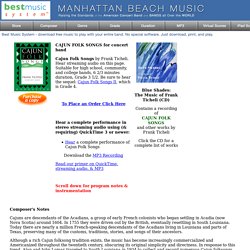
In 1755 they were driven out by the British, eventually resettling in South Louisiana. Today there are nearly a million French-speaking descendants of the Acadians living in Louisiana and parts of Texas, preserving many of the customs, traditions, stories, and songs of their ancestors. Although a rich Cajun folksong tradition exists, the music has become increasingly commercialized and Americanized throughout the twentieth century, obscuring its original simplicity and directness. In response to this trend, Alan and John Lomax traveled to South Louisiana in 1934 to collect and record numerous Cajun folksongs in the field for the Archive of Folk Music in the Library of Congress. By doing so, they helped to preserve Cajun music in its original form as a pure and powerful expression of Louisiana French Society.
Introduction to Cajun, Louisiana Creole & zydeco music. By Jim Hobbs Cajun, Louisiana Creole & Zydeco Music Search home Who are the Cajuns?

What is Cajun music and where did it come from? The French colonized Canada beginning in 1604, with many settling in what is now Nova Scotia but was then called Acadie. Significant Albums, Artists and Songs. Difference Between Cajun Music and Zydeco? By Megan Romer Question: What is the difference between Cajun Music and Zydeco?
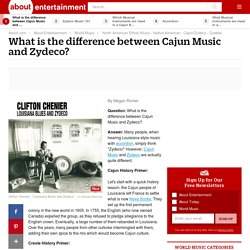
Answer: Many people, when hearing Louisiana-style music with accordion, simply think "Zydeco! " However, Cajun Music and Zydeco are actually quite different. Cajun History Primer: Let's start with a quick history lesson: the Cajun people of Louisiana left France to settle what is now Nova Scotia. Creole History Primer: The black Creole people have a quite different story. Continue reading below our video Play Video Les Gens Libres du Couleur, or Free Men of Color, were a group of property-owning free Black people. Reading/Research Room. The following summary of the history of Cajun, Creole, and Zydeco music is based entirely on information included in the sources listed at the bottom of the page.

Anyone who wants to gain an understanding of the development of French music in Southwest Louisiana needs to start with these sources. History of Cajun Country. CAJUN ('ka:-j@n), n.
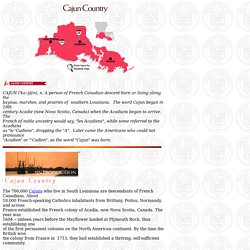
A person of French Canadian descent born or living along the bayous, marshes, and prairies of southern Louisiana. The word Cajun began in 19th century Acadie (now Nova Scotia, Canada) when the Acadians began to arrive. The French of noble ancestry would say, "les Acadiens", while some referred to the Acadians as "le 'Cadiens", dropping the "A". Later came the Americans who could not pronounce "Acadien" or "'Cadien", so the word "Cajun" was born.
Establishing Borders: The Expansion of the United States, 1846-48. Revival of Expansionism in the 1840sIntroduction - Revival of Expansionism - The Oregon Question - War With Mexico.
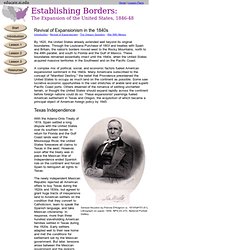
Between 1803 and 1853, the United States almost tripled in size.

In the early 1800s, the land west of the United States was very undeveloped. Many considered it to be uncivilized and underdeveloped even though it was home to many native peoples, as well as setters from France, Spain, Mexico and other countries. However, the U.S. truley believe it was their Manifest Destiny, obvious fate, to spread the idea of liberty and democracy to this land. They also felt it was their duty to civilize it by bringing in roads, railroads, the telegram, etc. It was at this time that America set out to gain control of this land. Expansion & Reform, 1800-1860. Northwest Ordinance; July 13, 1787. Northwest Ordinance; July 13, 1787 An Ordinance for the government of the Territory of the United States northwest of the River Ohio.

Section 1. Be it ordained by the United States in Congress assembled, That the said territory, for the purposes of temporary government, be one district, subject, however, to be divided into two districts, as future circumstances may, in the opinion of Congress, make it expedient. Sec 2. Sec. 3. Sec. 4. Sec. 5. Sec. 6. LIBERTY! . Northwest Ordinance. The Northwest Ordinance established a means and precedence by which the United States could expand westward.
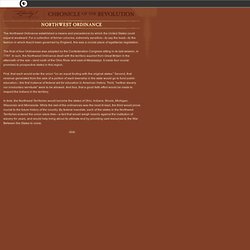
For a collection of former colonies, extremely sensitive—to say the least—to the fashion in which they'd been governed by England, this was a crucial piece of egaliterian legislation. The Northwest Ordinance of 1787 Explained in 3 Minutes: US History Review. Louisiana Purchase, 1803 - 1801–1829 - Milestones - Office of the Historian. Louisiana Purchase, 1803 The Louisiana Purchase refers to the 530,000,000 acres of territory in North America that the United States purchased from France in 1803 for US $15 million. The Louisiana Purchase. The U.S.-Mexican War . Prelude to War . Expansionism and Imperialism. Expansionism and Imperialism By Thomas Hietala. History. Congress enacts the Northwest Ordinance — History.com This Day in History — 7/13/1787.
On this day in 1787, Congress enacts the Northwest Ordinance, structuring settlement of the Northwest Territory and creating a policy for the addition of new states to the nation. The members of Congress knew that if their new confederation were to survive intact, it had to resolve the states' competing claims to western territory. In 1781, Virginia began by ceding its extensive land claims to Congress, a move that made other states more comfortable in doing the same. In 1784, Thomas Jefferson first proposed a method of incorporating these western territories into the United States.
His plan effectively turned the territories into colonies of the existing states. Ten new northwestern territories would select the constitution of an existing state and then wait until its population reached 20,000 to join the confederation as a full member. American History USA. Map of the Northwest Territory, including a depiction of the Township system In its brief existence, the Confederation Congress passed little legislation of lasting import. One of the few exceptions was the Northwest Ordinance of 1787, which controlled the admission of the Midwest states and laid the legal groundwork for their functioning.
One of Thomas Jefferson's often overlooked accomplishments is the work that he devoted to this plan. Less renowned but equally important advocates were Nathan Dane and Rufus King. Westward Expansion: The Louisiana Purchase. One of the first colored illustrations to be put into print, John H.B. Latrobe's The Balise. Mississippi River captures the haunting image of a navigation station under a full moon at the mouth of the Mississippi River. Jefferson's plans for the nation depended upon western expansion and access to international markets for American farm products. The Louisiana Purchase Video - Shmoop. Louisiana Purchase - Facts & Summary. War of 1812 - Facts & Summary. War of 1812–1815 - 1801–1829 - Milestones - Office of the Historian.
War of 1812–1815 As an important neutral trading nation, the United States became ensnarled in the European conflict that pitted Napoleonic France against Great Britain and her continental allies. Canal History - New York State Canals. The New York State Canal System is not only rich in history, but also culture. Many immigrants worked long and hard on "Clinton’s Ditch" to create this magnificent waterway. Folklore, songs and speech lingo emerged from those individuals working along the Canal. The U.S.-Mexican War . Prelude to War . Manifest Destiny: An Introduction. An Introduction No nation ever existed without some sense of national destiny or purpose.
Manifest Destiny – a phrase used by leaders and politicians in the 1840s to explain continental expansion by the United States – revitalized a sense of "mission" or national destiny for Americans. Antebellum Era. Industrial Revolution - Facts & Summary. The First Women's Rights Convention - Women's Rights National Historical Park. Seneca Falls in 1848 - Women's Rights National Historical Park.
Abolition, Women's Rights, and Temperance Movements - Women's Rights National Historical Park. Women in the 19th Century: Crash Course US History #16. The Erie Canal and the Network to Freedom - Women's Rights National Historical Park. Jacksonian Democracy and Modern America. Andrew Jackson rose to national prominance as a General during the War of 1812. The presidential election of 1828 brought a great victory for Andrew Jackson.
Jacksonian Democracy - Facts & Summary. Such tendentious revisionism may provide a useful corrective to older enthusiastic assessments, but it fails to capture a larger historical tragedy: Jacksonian Democracy was an authentic democratic movement, dedicated to powerful, at times radical, egalitarian ideals—but mainly for white men. Industrial Revolution - Social Studies. Coal, Steam, and The Industrial Revolution: Crash Course World History #32. Monroe Doctrine, 1823 - 1801–1829 - Milestones - Office of the Historian. The Monroe Doctrine. The War of 1812. For two and a half years, Americans fought Against the British, Canadian colonists, and native nations. Building the Erie Canal. Louisiana Voodoo.